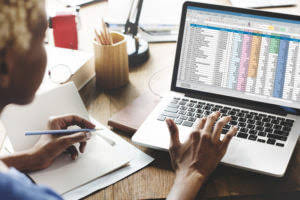Content

Each category should end with the total value of assets, liabilities, and equity of each category. Bear in mind that the total amount of asset values balance the liabilities and equity. A second category of assets presented on the classified balance sheet includes long-term assets. They are called long-term because it is assumed it may take more than a year to sell.

Once used primarily by larger companies, small business owners can also benefit from running a classified balance sheet. For example, by using the accounting equation, you can see if you should pay off debts with assets like your cash reserves or if you should take on more liabilities.
Classified Balance Sheet Format
This will let you pinpoint specific assets, equities, and liabilities that must be tracked consistently. While in the case of an unclassified balance sheet, no such bifurcation of components is made. Though it is easier to prepare, it leads to confusion since making decisions from such a balance sheet becomes difficult. Often these liabilities will include 5 to 30-year notes, in which case the portion that will not be due within the current liabilities period will be listed here. However, keep in mind that you have no particular requirements when crafting a classified balance sheet, and a company may list very different accounts that represent the maximum utility for their own purposes. It corresponds to the amount paid to the shareholders if a company is liquidated and all assets are sold out. Similar to assets, liabilities are categorized by current and long-term.

The cookie is used in context with transactions on the website.x-cdnThis cookie is set by PayPal. Should be familiar, representing the accumulated income less the dividends. In essence, it is the profit that has been retained and plowed back into expansion of the business. Includes the land, buildings, and equipment productively in use by the company. Some assets are valued at historical, or book value like land and machinery, and some have a more complex way of calculations like goodwill and brand name. Best Of We’ve tested, evaluated and curated the best software solutions for your specific business needs. Each side of the equation has to be equal, as you make purchases with either debt or capital.
How To Determine The Fair Market Value Of Assets
Here is the list of detailed classifications most of the classified balance sheet contains. Is the section used to report asset accounts that just don’t seem to fit elsewhere, such as a special long-term receivable. Additional Paid-in CapitalAdditional paid-in capital or capital surplus is the company’s excess amount received over and above the par value of shares from the investors during an IPO. It is the profit a company gets when it issues the stock for the first time in the open market.
A balance sheet summarizes a company’s financial position as of a certain date, typically at the end of a fiscal quarter or year. It presents the company’s total asset base, balanced against total liabilities and shareholders’ equity. Net earnings, reported on the income statement, flow through to shareholders’ equity on the balance sheet. Increases and decreases in assets and liabilities are used to reconcile net earnings with operating cash flows on the statement of cash flows. In Classified Balance Sheet Format, there are three basic elements of like Assets, Liabilities and shareholder equity. Information regarding their details can either be provided by wider categories or it can be presented by subcategories to show classification of its basic elements. A classified balance sheet is a financial statement with classifications like current assets and liabilities, long-term liabilities and other things.
Peggy James is a CPA with over 9 years of experience in accounting and finance, including corporate, nonprofit, and personal finance environments. She most recently worked at Duke University and is the owner of Peggy James, CPA, PLLC, serving small businesses, nonprofits, solopreneurs, freelancers, and individuals. If a company has surplus cash available and it sees a valuable investment opportunity in some other business, it can decide to buy a stake in it. For a more detailed look into stockholders’ equity many companies also prepare a statement of changes in stockholders’ equity showing stockholders’ equity at both the beginning and end of the year. Those obligation which will be payable after a year is called long term liabilities. The information featured in this article is based on our best estimates of pricing, package details, contract stipulations, and service available at the time of writing. Pricing will vary based on various factors, including, but not limited to, the customer’s location, package chosen, added features and equipment, the purchaser’s credit score, etc.
Add Shareholders’ Equity And Total Liabilities
The same is true for long-term liabilities, where the company typically uses these funds to purchase long-term assets. Unclassified balance sheets are used more for internal reporting and closely resemble the company’s trial balance, which contains balance sheet line items listed in ascending order from short-term to long-term.
For example, you can take totals of current assets and current liabilities in the classified balance sheet to calculate the current ratio. A balance sheet with classifications such as current assets, property plant and equipment, current liabilities, long term liabilities, etc. Current assets include resources that are consumed or used in the current period. Also, merchandise inventory is classified on the balance sheet as a current asset. The contracts of most small construction businesses can generally be completed in one year or less. Although a company such as this may present an unclassified balance sheet, a classified one is preferable.
One way that contractors can help themselves and those who read their financial statements is by creating a classified balance sheet. Public companies, on the other hand, are required to obtain external audits by public accountants, and must also ensure that their books are kept to a much higher standard.
These classifications aren’t mandatory, so you’re free to take a different approach in your business. Some companies organize the balance sheet with an order-of-liquidity approach, AccountingTools says. To ensure you’re allocating resources effectively, you’ll want to run financial reports often.
Pay attention to the balance sheet’s footnotes in order to determine which systems are being used in their accounting and to look out for red flags. Fixed assets include land, machinery, equipment, buildings, and other durable, generally capital-intensive assets. The balance sheet provides an overview of the state of a company’s finances at a moment in time. It cannot give a sense of the trends playing out over a longer period on its own.
Format Of A Classified Balance Sheet
Think of the balance sheet as a photograph of the business at a specific point in time. As of this date, the balance sheet measures the financial condition of Harbour Island Company. In fact, some companies refer to the balance sheet as the statement of financial condition. A classified balance sheet is a format of detailed presentation of the assets and liabilities of an organization. It provides details of every asset held for current use and for long term purpose. It also provides details of every liability to be paid in the near future and every liability to be paid in the long term. It helps the user of financial statements estimate the financial position clearly.
If several persons are involved in a business that is not incorporated, it is likely a partnership. Relate to any obligation that is not current, and include bank loans, mortgage notes, certain deferred taxes, and the like.
- Additionally, return on investment can be pinpointed more efficiently.
- For example, a service provider will have very different accounts than a manufacturer.
- Current assets include resources that are consumed or used in the current period.
- By subtracting the total liabilities from total assets, financial statement users can calculate the actual value of the company.
- It conveys a strong message to the investors that their money is safe as management is serious not only about the business profitability but also running it ethically and within the rules of the land.
However, overall, current asset items are still relatively more liquid in nature than the fixed assets or intangible assets. Classified Balance Sheet is often use by companies to improve users’ understanding of a company’s financial position. Financial Statements of the company show its financial health, position and its operational activities. Balance Sheet is a principal financial statement which shows the financial standing of the company at a particular time. It presents the snapshot of the company’s position at the date it is prepared. Other titles of balance sheet include statement of financial position and statement of financial condition.
Current Assets And Liabilities
By organizing the information into categories, it can be easier to read and extract the information you need than if it was simply listed in a large number of line items. It also gives users more information about the company and its operations. For example, investors and creditors can use measurements like the current ratio to assess a company’s solvency and leverage by comparing current assets and liabilities. Categorizing the balance sheet into current and long-term categories allows those to be easily accomplished.

It further includes initial paid-up capital and additional paid-up capital. Based on the reporting, there are two accounting standards as underlined by IFRS and GAAP US.
The income statement and statement of cash flows also provide valuable context for assessing a company’s finances, as do any notes or addenda in an earnings report that might refer back to the balance sheet. These are the assets that one can quickly convert into cash and use for paying the near-term liabilities. Under this category, the assets that one can convert into cash within one year or within one operating cycle come. While listing the assets on the balance sheet, the most liquid assets or the ones that one can easily convert into cash should come first. The classified balance sheet shows various information under different subcategories. In simpler terms, the major items such as assets, shareholders’ equity & liabilities, and so on are further sub-categorized. The organizations do that to make it more easily readable in comparison to the usual listing of all the accounts in the balance sheet.
The classified balance sheet is more dynamic and detailed in this regard. All these classifications must work according to the proposition that total assets must be equal to the sum of total liabilities and shareholder’s equity. However, it is important to first classify the assets and liabilities and current and non-current as a bare minimum. Further, accounting standards may prescribe minimum reporting line items. The financial statements shall be prepared in such a manner that they provide a true and fair view of the business’s financial affairs to the users of the statement. Common current liabilities include accounts payable, accrued expenses, current portions of long-term debt, and shareholder loans.
Common Classifications In Balance Sheet
Accounts PayableAccounts payable is the amount due by a business to its suppliers or vendors for the purchase of products or services. It is categorized as current liabilities on the balance sheet and must be satisfied within an accounting period. Accounts ReceivableAccounts receivables is the money owed to a business by clients for which the business has given services or delivered a product but has not yet collected payment. They are categorized as current assets on the balance sheet as the payments expected within a year. The classified balance sheet uses sub-categories or classifications to further break down asset, liability, and equity categories. Smaller businesses typically use an unclassified balance sheet, but if you’re looking for a report that provides the same data in a more detailed format, you’ll want to prepare a classified balance sheet.
Long Term Assets And Liabilities
Whatever system of classification is used should be applied on a consistent basis, so that balance sheet information is comparable over multiple reporting periods. There’s no standardized set of subcategories or required amount that must be used. Management can decide what types of classifications to use, but the most https://www.bookstime.com/ common tend to be current and long-term. Sureties typically want financial statements that, first and foremost, conform to Generally Accepted Accounting Principles rather than an ad hoc or special purpose framework. They also usually require comparative statements, often covering a three- to five-year period.
